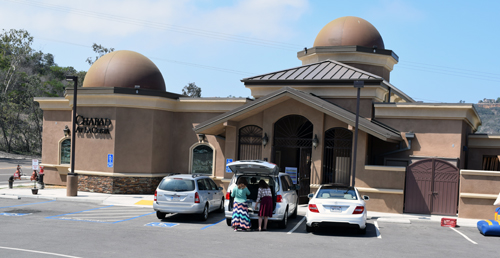
By Donald H. Harrison
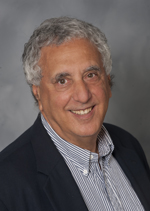
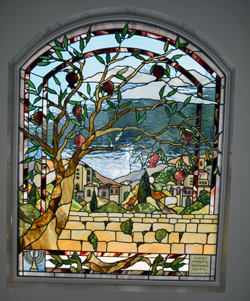
CARLSBAD, California – Chabad of La Costa on Sunday, Aug. 23, celebrated the completion of what its spiritual leader, Rabbi Yeruchem Eilfort, called the “floor of the present” containing an 88-seat sanctuary, offices, a small library, and a kosher kitchen.
Already roughly constructed, but needing such important finishing touches as an elevator, is a bottom floor or the “floor of the future” of the double-domed building at 1980 La Costa Avenue in which Eilfort hopes to install pre-school classrooms, a teacher’s lounge, a larger library, and a walk-in freezer.
After a $3 million campaign to construct the building and finish the “floor of the present,” Eilfort said he wants to rest a while before he starts fundraising to complete the lower level. Maybe even until after Chanukah when the first floor will be dedicated formally.
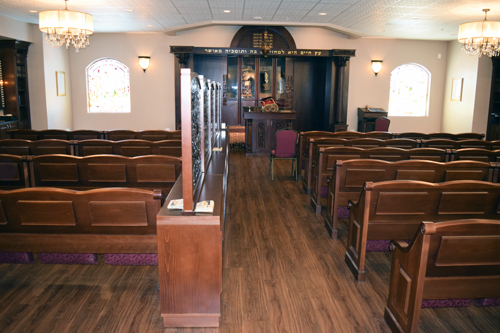
Visitors who toured the facility found much to see, including four stained glass windows in the sanctuary which were commissioned and conceptualized by Channah Hale and executed by glass artist Leslie Thieda of Vista. From the perspective of those sitting in the sanctuary, the stained glass window to the left of the large menorah-carved doors of the Aron Kodesh includes a scene of the Old City of Jerusalem framed by the branch of a pomegranate tree. The arch of the pomegranate tree branch is reminiscent of a wedding chuppah, so Hale dedicated the window to her husband, Arthur Hale.
To the right of the bima is another view of Jerusalem’s Old City, dedicated to the donor’s parents Bluma and Dovid Glovsky.

Along the right side of the sanctuary, near the rear of the room, are two other windows. The one closest to the ark shows the Lions of Judah holding up the Ten Commandments. Notes Hale: “If you read the midrashes, you will find that when Moses came down with the second set of tablets they were written by the hand of God on sapphire. Therefore our tablets are in blue. The description of the tablets were straight across, not like Cecil B. DeMille’s arched tablets. So they are not arched, they are rectangular.” This window is dedicated to Hale’s maternal grandfather Abraham Seigal, her grandmother Baile, and stop-grandmother Mollie.
The fourth stained window in the sanctuary is a menorah, which carries out the menorah theme found on the doors of the Aron Kodesh as well as within the two stained glassed windows on either side of the bima. It is dedicated to Hale’s paternal grandparents Jacob and Rebecca Glovsky.
Hale said she was prompted to donate the stained glass windows because when she saw the sanctuary windows initially in plain glass, “you could see the traffic going by and it was distracting.”
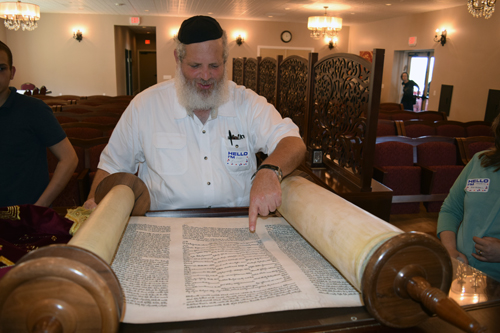
The sanctuary is filled with stories including one that Rabbi Eilfort tells with a certain sense of wonder.
A congregant by name of Ed Richard observes the yahrzeit of his parents on Shabbos Shuvah, the Sabbath between Rosh Hashanah and Yom Kippur. In 2001, that came ten days after the 9-11 terrorist attacks on New York City and Washington D.C. Eilfort said that Richard was so moved by that catastrophic day that he decided “we have to fight the darkness of terrorism with light.”
“And what is light?” asked Eilfort rhetorically. “The Torah!”
So Richard decided to dedicate a Torah, which proudly sits within Chabad of La Costa’s Aron Kodesh.
A few years later, he decided he wanted to dedicate another Torah – but this time, he told the rabbi, it should be one that was saved from the Holocaust.
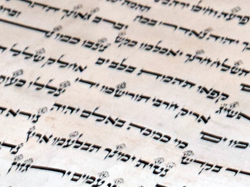
Subsequently, rabbis throughout the San Diego County region received an email from a man in Chula Vista wanting to sell a Torah that had been his father’s. Eilfort remembers he drove in blinding rain from Carlsbad to Chula Vista to see it, and when he opened it, the script took his breath away. “It was written with extra flourishes (hidurim) that aren’t used anymore. I looked at it and it was so beautiful and well-preserved considering what it had been through.” He received permission from the owner to take it Alberto Attia, the well known sofer in San Diego, who made certain the Torah was still kosher. It was.
Before completing the purchase, Eilfort asked the owner to tell him everything he knew about the Torah’s provenance. He responded that his father had purchased it in Europe, and that it was his understanding that it had been buried under the basement either of the synagogue which it had served or that of the gabbai’s house.
“Where was that?” asked the rabbi.
“Carlsbad, Czechoslovakia,” the man responded.
Good story teller that he is, the rabbi paused for a moment to let the coincidence sink in. Imagine, he said, “it went from Carlsbad to Carlsbad!”
In the synagogue’s kosher kitchen, caterer Sheila Leibowitz meanwhile was whipping out hot dogs, lemonade, and honey cakes, and elsewhere in the synagogue, the rabbi’s son, Mendel Eilfort, prepared to demonstrate the kind of calligraphy used in inscribing the Torah.
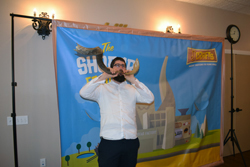
Additionally, Rabbi Aron Teleshevsky of the Shofar Factory brought part of his collection of shofars down from Los Angeles in order to show children (and their parents and grandparents) “how a shofar is made, what makes a shofar kosher or not kosher, and the significance of a shofar.” With Yom Kippur on the near horizon, he said, “they will have the opportunity to blow a shofar” as well.
Eilfort related that Chabad of La Costa in 1991 rented on the property a pre-fabricated building that previously had been used as an outbuilding during the construction of the nearby La Costa resort, which had opened in 1965. Although separated by its elevation, the property was considered part of the shopping center below at the corner of El Camino Real and La Costa Avenue.
When the shopping center changed hands, Eilfort entreatied the new owners to sell that piece so he could build a synagogue. That accomplished, the Eilforts began their building campaign in 2009. Optimistically believing that a new synagogue could be constructed for $1 million, Eilfort watched in dismay as costs climbed to triple that amount. But donors got behind the project.
During construction, the congregation occupied crowded, temporary quarters across the street, suffering over a year and a half a dip in membership. Now, however, said a smiling Eilfort, membership is rising again to approximately 100 families. Sunday barbecues held on the property have been a big hit, and “everything is going back up again.”
*
Harrison is editor of San Diego Jewish World. He may be contacted via donald.harrison@sdjewishworld.com